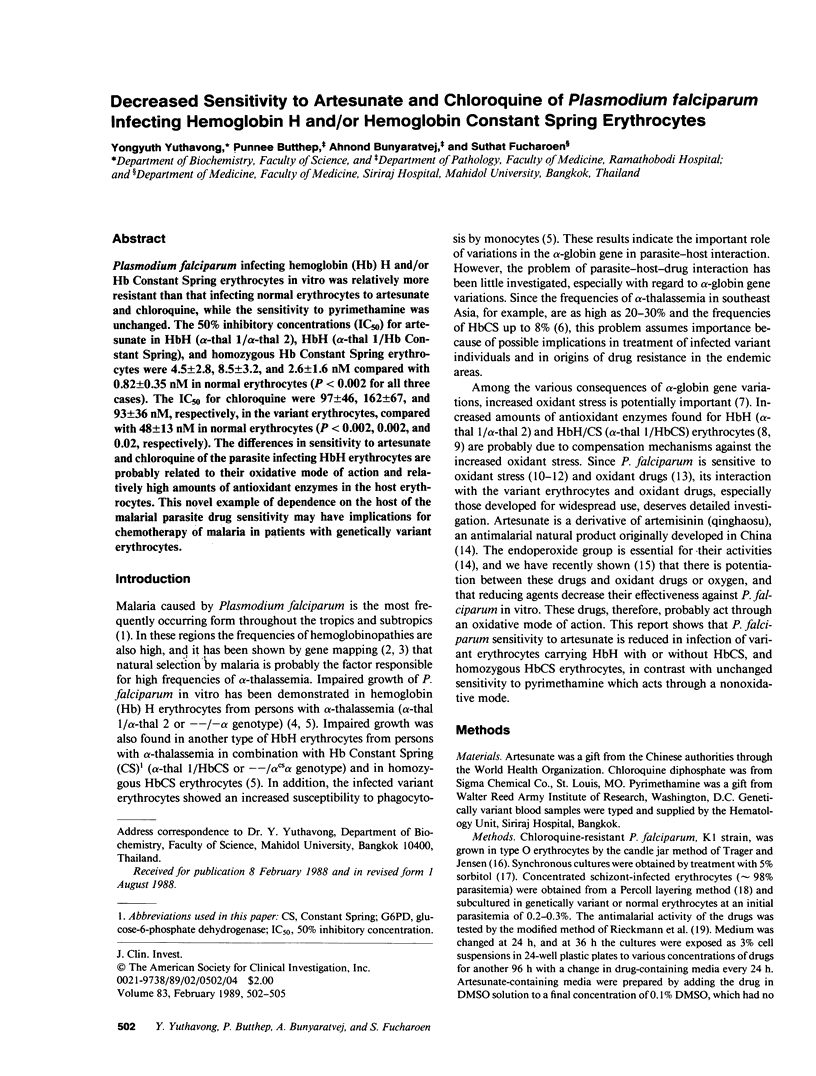Abstract
Plasmodium falciparum infecting hemoglobin (Hb) H and/or Hb Constant Spring erythrocytes in vitro was relatively more resistant than that infecting normal erythrocytes to artesunate and chloroquine, while the sensitivity to pyrimethamine was unchanged. The 50% inhibitory concentrations (IC50) for artesunate in HbH (alpha-thal 1/alpha-thal 2), HbH (alpha-thal 1/Hb Constant Spring), and homozygous Hb Constant Spring erythrocytes were 4.5 +/- 2.8, 8.5 +/- 3.2, and 2.6 +/- 1.6 nM compared with 0.82 +/- 0.35 nM in normal erythrocytes (P less than 0.002 for all three cases). The IC50 for chloroquine were 97 +/- 46, 162 +/- 67, and 93 +/- 36 nM, respectively, in the variant erythrocytes, compared with 48 +/- 13 nM in normal erythrocytes (P less than 0.002, 0.002, and 0.02, respectively). The differences in sensitivity to artesunate and chloroquine of the parasite infecting HbH erythrocytes are probably related to their oxidative mode of action and relatively high amounts of antioxidant enzymes in the host erythrocytes. This novel example of dependence on the host of the malarial parasite drug sensitivity may have implications for chemotherapy of malaria in patients with genetically variant erythrocytes.
Full text
PDF



Selected References
These references are in PubMed. This may not be the complete list of references from this article.
- Clark I. A., Hunt N. H. Evidence for reactive oxygen intermediates causing hemolysis and parasite death in malaria. Infect Immun. 1983 Jan;39(1):1–6. doi: 10.1128/iai.39.1.1-6.1983. [DOI] [PMC free article] [PubMed] [Google Scholar]
- Dejkriengkraikhul P., Santiyanont R., Wilairat P. A rapid method for concentrating schizont-infected red cells of Plasmodium falciparum. Southeast Asian J Trop Med Public Health. 1982 Dec;13(4):663–665. [PubMed] [Google Scholar]
- Derry S., Wood W. G., Pippard M., Clegg J. B., Weatherall D. J., Wickramasinghe S. N., Darley J., Fucharoen S., Wasi P. Hematologic and biosynthetic studies in homozygous hemoglobin Constant Spring. J Clin Invest. 1984 Jun;73(6):1673–1682. doi: 10.1172/JCI111374. [DOI] [PMC free article] [PubMed] [Google Scholar]
- Ellis D. S., Li Z. L., Gu H. M., Peters W., Robinson B. L., Tovey G., Warhurst D. C. The chemotherapy of rodent malaria, XXXIX. Ultrastructural changes following treatment with artemisinine of Plasmodium berghei infection in mice, with observations of the localization of [3H]-dihydroartemisinine in P. falciparum in vitro. Ann Trop Med Parasitol. 1985 Aug;79(4):367–374. [PubMed] [Google Scholar]
- Flint J., Hill A. V., Bowden D. K., Oppenheimer S. J., Sill P. R., Serjeantson S. W., Bana-Koiri J., Bhatia K., Alpers M. P., Boyce A. J. High frequencies of alpha-thalassaemia are the result of natural selection by malaria. Nature. 1986 Jun 19;321(6072):744–750. doi: 10.1038/321744a0. [DOI] [PubMed] [Google Scholar]
- Friedman M. J. Oxidant damage mediates variant red cell resistance to malaria. Nature. 1979 Jul 19;280(5719):245–247. doi: 10.1038/280245a0. [DOI] [PubMed] [Google Scholar]
- Golenser J., Miller J., Spira D. T., Navok T., Chevion M. Inhibitory effect of a fava bean component on the in vitro development of Plasmodium falciparum in normal and glucose-6-phosphate dehydrogenase deficient erythrocytes. Blood. 1983 Mar;61(3):507–510. [PubMed] [Google Scholar]
- Ifediba T. C., Stern A., Ibrahim A., Rieder R. F. Plasmodium falciparum in vitro: diminished growth in hemoglobin H disease erythrocytes. Blood. 1985 Feb;65(2):452–455. [PubMed] [Google Scholar]
- Jiang J. B., Jacobs G., Liang D. S., Aikawa M. Qinghaosu-induced changes in the morphology of Plasmodium inui. Am J Trop Med Hyg. 1985 May;34(3):424–428. doi: 10.4269/ajtmh.1985.34.424. [DOI] [PubMed] [Google Scholar]
- Klayman D. L. Qinghaosu (artemisinin): an antimalarial drug from China. Science. 1985 May 31;228(4703):1049–1055. doi: 10.1126/science.3887571. [DOI] [PubMed] [Google Scholar]
- Krungkrai S. R., Yuthavong Y. The antimalarial action on Plasmodium falciparum of qinghaosu and artesunate in combination with agents which modulate oxidant stress. Trans R Soc Trop Med Hyg. 1987;81(5):710–714. doi: 10.1016/0035-9203(87)90003-4. [DOI] [PubMed] [Google Scholar]
- Lambros C., Vanderberg J. P. Synchronization of Plasmodium falciparum erythrocytic stages in culture. J Parasitol. 1979 Jun;65(3):418–420. [PubMed] [Google Scholar]
- Payne D. Spread of chloroquine resistance in Plasmodium falciparum. Parasitol Today. 1987 Aug;3(8):241–246. doi: 10.1016/0169-4758(87)90147-5. [DOI] [PubMed] [Google Scholar]
- Prasartkaew S., Bunyaratvej A., Fucharoen S., Wasi P. Comparison of erythrocyte antioxidative enzyme activities between two types of haemoglobin H disease. J Clin Pathol. 1986 Dec;39(12):1299–1303. doi: 10.1136/jcp.39.12.1299. [DOI] [PMC free article] [PubMed] [Google Scholar]
- Rieckmann K. H., Campbell G. H., Sax L. J., Mrema J. E. Drug sensitivity of plasmodium falciparum. An in-vitro microtechnique. Lancet. 1978 Jan 7;1(8054):22–23. doi: 10.1016/s0140-6736(78)90365-3. [DOI] [PubMed] [Google Scholar]
- Trager W., Jensen J. B. Human malaria parasites in continuous culture. Science. 1976 Aug 20;193(4254):673–675. doi: 10.1126/science.781840. [DOI] [PubMed] [Google Scholar]
- Waki S., Gu H. M., Zhu M. Y. Sensitivity of malaria parasites to artemether (qinghaosu derivative) depends on host cell age. Trans R Soc Trop Med Hyg. 1987;81(6):913–914. doi: 10.1016/0035-9203(87)90348-8. [DOI] [PubMed] [Google Scholar]
- Wasi P., Pootrakul P., Fucharoen S., Winichagoon P., Wilairat P., Promboon A. Thalassemia in southeast Asia: determination of different degrees of severity of anemia in thalassemia. Ann N Y Acad Sci. 1985;445:119–126. doi: 10.1111/j.1749-6632.1985.tb17181.x. [DOI] [PubMed] [Google Scholar]
- Wozencraft A. O., Dockrell H. M., Taverne J., Targett G. A., Playfair J. H. Killing of human malaria parasites by macrophage secretory products. Infect Immun. 1984 Feb;43(2):664–669. doi: 10.1128/iai.43.2.664-669.1984. [DOI] [PMC free article] [PubMed] [Google Scholar]
- Yenchitsomanus P. T., Summers K. M., Bhatia K. K., Cattani J., Board P. G. Extremely high frequencies of alpha-globin gene deletion in Madang and on Kar Kar Island, Papua New Guinea. Am J Hum Genet. 1985 Jul;37(4):778–784. [PMC free article] [PubMed] [Google Scholar]
- Yenchitsomanus P., Wasi P. Increased erythrocyte superoxide dismutase activities in beta 0-thalassaemia/haemoglobin E and in haemoglobin H diseases. J Clin Pathol. 1983 Mar;36(3):329–333. doi: 10.1136/jcp.36.3.329. [DOI] [PMC free article] [PubMed] [Google Scholar]
- Yuthavong Y., Butthep P., Bunyaratvej A., Fucharoen S., Khusmith S. Impaired parasite growth and increased susceptibility to phagocytosis of Plasmodium falciparum infected alpha-thalassemia or hemoglobin Constant Spring red blood cells. Am J Clin Pathol. 1988 Apr;89(4):521–525. doi: 10.1093/ajcp/89.4.521. [DOI] [PubMed] [Google Scholar]


